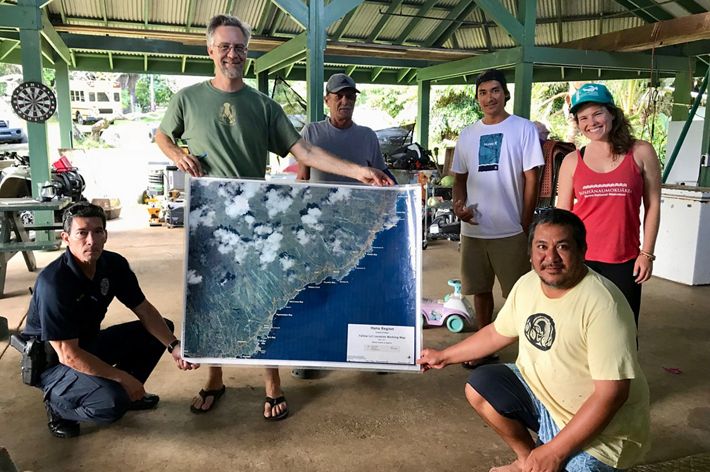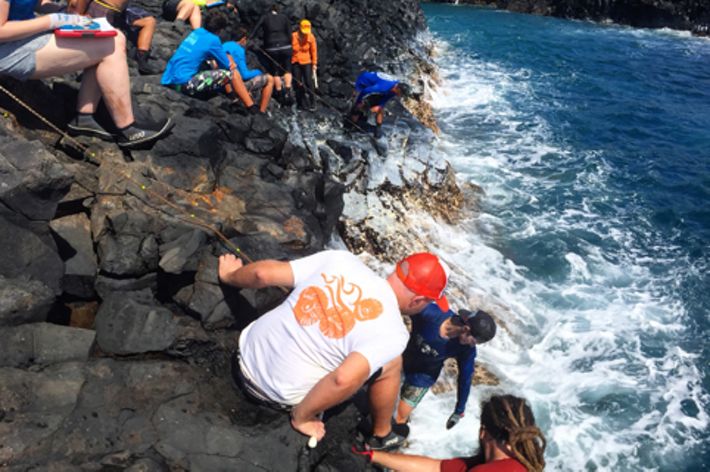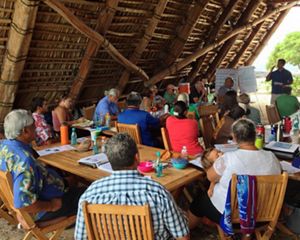East Maui
Island of Maui

Protecting Traditional Subsistence Practices for Future Generations
East Maui communities lead the way in managing the island’s nearshore and subsistence resources.
Like many communities in East Maui, Kīpahulu is a traditional fishing and gathering area, sustaining the local and Hawaiian population for centuries. Its approximately 150 residents live off the grid, generating their own power and obtaining fresh water through streams, wells and catchment systems. Yet, this remote moku, or district, annually attracts up to two million visitors to the Haleakalā National Park. To ensure the perpetuation of cultural practices, including the subsistence lifestyle of families across the moku, a small group of Native Hawaiians came together and founded the nonprofit Kīpahulu ‘Ohana, Inc. in 1995.
Building on their popular educational programs and successful restoration of upland, or mauka, areas, they expanded their stewardship to include marine, or makai, areas. TNC has supported these efforts since 2010, surveying the area’s fish and coral populations and providing tools and technical assistance for creating a makai resource management plan and a community-based monitoring program. Community-led activities and workshops resulted in the development of their Mālama I Ke Kai Plan in 2012, where a Community-Based Subsistence Fishing Area (CBSFA) designation for Kīpahulu Moku was identified as a priority action.
A CBSFA designation codifies traditional and customary practices into new fishing rules, where the State can leverage community-based knowledge and cooperation to promote lawai‘a pono, or responsible fishing, and implement fishery governance and management strategies. Kīpahulu ‘Ohana chose to pursue a CBSFA because it is the only fisheries management area designation in Hawai‘i that emphasizes the perpetuation of traditional practices and a Hawaiian lifestyle, along with the protection and management of fisheries. Their CBSFA proposal reflects extensive input from East Maui residents and—with 100% support from the community—was unanimously approved by the Board of Land and Natural Resources and signed into law by Governor Josh Green in 2024. Read a local news story announcing this milestone.
Kīpahulu ‘ohana members, Division of Conservation and Resources Enforcement officer and TNC Maui Marine Program staff collaborate to protect the Kīpahulu moku through a CBSFA designation.
With new tools and robust data from surveys and community monitoring to complement decades of observation, Kīpahulu ‘Ohana has a better understanding of the status of makai resources and is well-equipped to assess the effectiveness of proposed management interventions, such as CBSFA rules and an ‘Opihi Rest Area fronting the Haleakalā National Park campground.
‘Opihi Rest Areas
Rest Areas, inspired by traditional knowledge and management practices, have been established to give ‘opihi populations a chance to recover. Three species of ‘opihi, aquatic limpets that cling to rocks on island shorelines, are found only in Hawai‘i and play a key role in coastal biodiversity. These delicacies, a staple of the Hawaiian diet, were once carefully managed to ensure thriving populations. But increasing demand and unsustainable harvest have resulted in dwindling ‘opihi populations across the state in the last century.
After monitoring and documenting a decline in ‘opihi populations along two miles of coastline over six years, Kīpahulu ‘Ohana and Nā Mamo O Mū‘olea decided to revive the traditional Hawaiian practice of resting an area to reverse the decline. In consultation with the scientific community, the groups established voluntary rest areas in 2014 where ‘opihi are not harvested to give the populations a chance to recover and to re-populate other areas through larval distribution down current.
At their request, TNC has been working with these community groups, kūpuna (respected elders) and government agencies in east Maui, and with others in the academic community to improve understanding of ‘opihi populations so that we can better care for them. ‘Opihi Rest Areas have been successful in increasing the population and density of ‘opihi, both within the rest areas and in down-current areas open for harvest. Between 2014 and 2017, nine out of the twelve survey areas within or down current from the rest area in Kīpahulu saw up to six-fold increases in the number of ‘opihi per meter.
The community groups conduct ongoing outreach to ensure people know about the voluntary rest areas, and they continue to monitor ‘opihi recovery along the coast. Their monitoring provides important insights into patterns of spawning and larval dispersal, guiding resource management decisions and improving the chances of restoring populations of this cultural delicacy so local communities can enjoy ‘opihi long into the future.
Beyond CBSFAS & 'Opihi
Inspired by these successes and a desire to perpetuate tradition and maintain their Hawaiian lifestyles, community groups from neighboring moku have come together to pursue regional fisheries management for all of East Maui, or Maui Hikina.
Kīpahulu ‘Ohana and Nā Mamo O Mū‘olea are members of the Maui Nui Makai Network, a TNC supported group comprised of community groups from Lāna‘i, Moloka‘i and Maui. Network members share knowledge and coordinate advocacy and education to enhance and accelerate makai conservation across the islands of Maui Nui. Visit their website to learn more about their work, including their leadership of the Maui Hikina Huliāmahi initiative.
Learn more about TNC’s tools and science, partnerships to restore makai areas and efforts to strengthen conservation management and leadership so Hawaiʻi's reefs can support healthy fisheries and prosperous communities long into the future.




